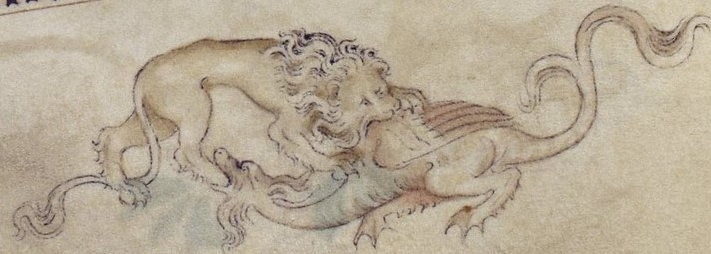Dragon
Once feared and respected as the most powerful beings to exist, dragons have all but disappeared from the Eastern Arm region of the world after the advent of humans learning magic. They still live strong in other areas of the world, however, and are still revered by some as lords and kings.
Basic Information
Anatomy
True dragons are large lizard-like creatures with four legs, the fore-feet being capable of being used as hands, a long neck and tail, and a pair of large wings. Depending on the variety, they can also sport horns at the crown of their skull, bony spines down the back, and a mace-like mass of bone at the end of the tail.
There are also false dragons, such as the legless amphithere, the lesser wyvern, the wingless drake, and the wyrm variants.
Dietary Needs and Habits
Despite requiring a large amount of meat in their diet, dragons are not obligate carnivores. They are capable of eating plants and even cooked foods from time to time, but this is only common among younger, smaller dragons and those that have gained the ability to morph themselves into mortal forms.
Biological Cycle
Once every hundred years a dragon will go into moult. During this time, old scales will begin to loosen and fall off a dragon's hide as new ones grow in. This can cause a lot of itching, and the process tends to creep from one part of the body to another, though this can take place over larger and larger areas as the dragon ages. While in moult, the affected areas will appear dull and rough, especially when compared to the new scaling. This is the most vulnerable time for a dragon as the shifting of the scales often leaves exposed patches of skin while the new scales are still growing in.
Dragons at least 500-years-old can hibernate for extended periods of time. In addition to them not requiring food or water during this time, making it ideal to do during a time of famine, it is said that hibernating halts the aging process. Many theorize that dragons that have many long periods of hibernation will live far longer than a dragon that hardly ever hibernates, though there is little evidence to back these claims. A dragon coming out of hibernation, however, will need more food than it otherwise would for a brief period while they recover from their extended slumber.
Additional Information
Uses, Products & Exploitation
Dragon scales are very strong, making them fine material for crafting armour and weapons, although their natural resistance to fire means that magical methods are required to effectively work with them.
Fangs, spines, horns, and other bony pieces of a dragon are popular decorative pieces among the wealthy. They are used as is or are sometimes carved and worked to create instruments, flatware, and even structural components of buildings.
Dragon's blood is a valuable alchemical ingredient, due to a dragon's close connection with the Weave. Some particularly powerful spells require it as a material component in their casting. It can also be crystallized into gemstones.
Average Intelligence
Dragons are highly intelligent creatures, arguably moreso than any of the humanoid races. Not only do they have the capability to wield magic as well as any Fey, but with many lifetimes to spare, dragons can and will study everything they can get their talons on in order to expand their knowledge. They have powerful memories and are capable of learning dozens of languages simply by osmosis. Those that do not choose to become scholars in their own right often go on to collect scholars' manuscripts as part of their hoards.
Civilization and Culture
Major Language Groups and Dialects
Vocally, dragons can only speak Draconic, a language that can only be properly communicated with deep bass tones and guttural growls. Adults, however, use their connection with the Weave to telepathically translate their speech to whomever it is they are speaking to. Those that can take human forms tend to attempt communicating in the common languages of the area they are in, but most will still resort to their telepathy to communicate effectively.
Lifespan
Unknown
Conservation Status
In the Cynian lands, dragons are considered a highly endangered and dangerous species. Debates are still held whether or not the creatures should be eradicated from the kingdom entirely, but there are some groups that are working to crossbreed dragons with the much smaller wyverns in order to create smaller, less-intelligent varieties of dragons that can be used as war mounts.
Dragons still live and thrive in the rest of the world, however, and the overall population is quite stable.
Average Height
5.4 m
Average Weight
3,000 kg
Average Length
18.3 m
Geographic Distribution



Comments